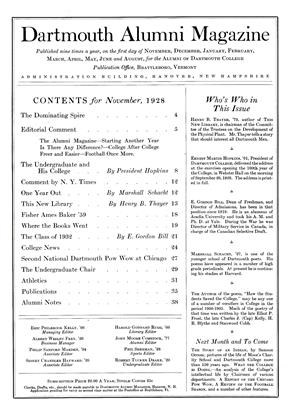Some fifty Dartmouth men and their families will leave the chilly side of Pier 9, North River, New York, on February 23, for the first annual cruise to the West Indies. The Dartmouth College Club of New York is sponsoring this trip, which will be taken on the United Fruit Company's steamship Pastores.
To cast aside the galoshes and furs in the middle of winter and set sail for the warmth and comfort of the Gulf Stream is a natural desire, and one that more and more people are fulfilling each year. To do this in the company of people you know and who talk your language, simply doubles the pleasure.
To many Caribbean travellers, the days and nights on board ship are lure enough, for with the ample deck space, the sports, dances, and just plain loafing in a deck chair, the time seemsto hurry along. But beyond this, the places visited and the things seen offer an added inducement. The trip touches the high spots of the West Indies. While many other ports could be touched, Havana, Jamaica, the Canal Zone and Costa Rica offer more interesting sights, more picturesque scenery and more amusement than is to be found elsewhere, plus the additional comforts that have been developed where American capital and knowledge has modernized living conditions without destroying the foreign atmosphere.
Leaving New York at a time when in all probability the weather forecasts will prophesy continued cold and snow, but two days elapse before the porpoises and the flying fish and the soft trade winds announce the Gulf Stream.
The first port of call is Havana, where in a setting essentially the same as in the days of the Spanish regime, one may see Morro Castle, Columbus Cathedral, the narrow streets, a sugar plantation, and at night simply watch or participate in the night life of a very gay capital.
Then after two days more of loafing in the sunshine on deck comes Jamaica, called with considerable truth the most beautiful island in the Caribbean—high green hills, every variety of tropical foliage, strange fruits and vegetables, picturesque shacks far off on the hillsides, and the spotlessly white town of Kingston and a night at a perfectly appointed hotel. The next day is one for shopping, golf or what you will.
After Jamaica comes a two-day sail due West, to the Canal. No one realizes without having seen it what a colossal job it was to dig out the back bone of the continental divide, and what a startling change it made in the world of ships. At Panama, the old and the new blend across a street, for the dividing line between the Zone which is distinctly American, and the Republic of Panama which is distinctly Spanish, lies in the middle of one of the roadways. There one sees the ruins of old Panama, sacked by the buccaneers at a time when it was the largest and richest city in the New World.
With Panama over the stern, comes Costa Rica, where more bananas grow to the square inch than anywhere else, and where the ship justifies its existence by loading up with what used to be the natural concomitant of corn flakes in the Commons.
Then for a last half day in Havana, a final look at the royal palms along the Malecon, and back to New York on March 17, with the grip of winter broken or at least bent while the cruise passengers were indulging in daily sunshine.
Advance reservations indicate a lively interest in this cruise, and it is expected that late deciders will have difficulty in finding room.
 View Full Issue
View Full Issue
More From This Issue
-
 Article
ArticleThis New Library
November 1928 By Henry B. Thayer, '79 -
 Article
ArticleThe Undergraduate and His College
November 1928 By President Hopkins -
 Class Notes
Class NotesCLASS OF 1914
November 1928 By John R. Burleigh -
 Article
ArticleThe Class of 1932
November 1928 By E. Gordon Bill -
 Lettter from the Editor
Lettter from the EditorEditorial Comment
November 1928 -
 Class Notes
Class NotesCLASS OF 1926
November 1928 By Charles D. Webster, Air Reduction







